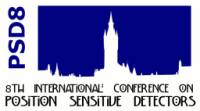Speaker
Mr
Alexander Grint
Description
This work describes the development of a dual layer Compton camera [1] to produce a 3D source image with a greater sensitivity than the mechanical collimation technique [2], presently used for SPECT (Single Photon Emission Computed Tomography) in medicine. The imaging of low energies is of particular importance as the current isotope of choice for SPECT in medicine is 99mTc, emitting photons of 140 keV. The Compton camera technique requires good energy resolution and position sensitivity. Segmented semiconductor detectors were selected as they provide excellent energy resolution and with the application of Pulse Shape Analysis (PSA) [3], the ability to determine the position of interaction beyond that of the detectors segmentation. An initial system of two HPGe planar detectors, (active volume of each crystal is 60 x 60 x 20mm3), resulted in a poor low energy imaging efficiency due to the crystal thickness. To overcome this, the front HPGe detector was replaced with a 0.5mm thick double sided silicon strip detector aiming to maximise the fraction of incident gamma rays scattering into the rear detector. Details of the characterisation measurements of the Silicon and Germanium detectors will be presented. Preliminary imaging results will be shown for the new Silicon/Germanium system and the previous Germanium/Germanium system [4], together with experimental details and efficiency comparison of both camera setups.
References
[1] M. Singh & D. Doria - An electrically collimated gamma camera for single photon emission computed tomography, Med Phys., vol. 10 pp. 421-427, 1983
[2] H. Anger. A new instrument for mapping gamma-ray emitters. Biology and Medicine Quarterly Report UCRL, 1957, 3653: 38. (University of California Radiation Laboratory, Berkeley)
[3] K. Vetter, NIM A 452 (2000) 223
[4] J. Gillam, School of Physics & Materials Engineering, Monash University, Australia

